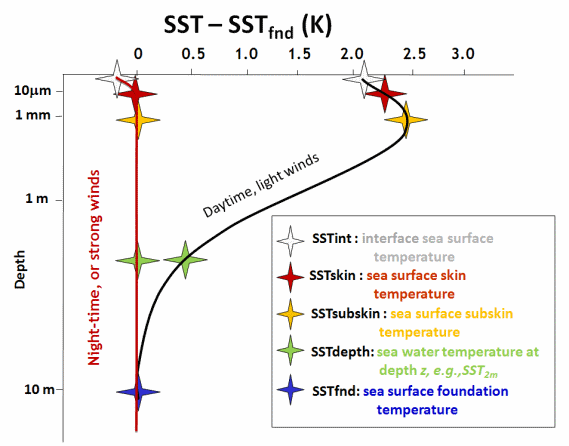SST physical meaning
SST is the measure of the energy created by the motion of molecules at the top layer of the ocean. But what does "top layer" mean? The first 10-m layer of the ocean down from the surface is characterized by complex and highly variable vertical temperature structure, that results from both:
- ocean turbulence;
- air-sea fluxes of heat, moisture and momentum.
When dealing with surface temperature data it is imperative to know very accurately to which depth in the ocean the measurement corresponds to. In other words, to understand the information content (i.e. what the data in each variable represents) and the relationship between measurements provided by different instruments (either by those onboard satellites or in situ) clear definitions are needed: the Group for High Resolution SST (GHRSST) proposed definitions of SST in the upper 10-m layer of the ocean.
In Figure 1, extracted from the GHRSST website, 2 hypotetical vertical temperature profiles in the first 10-m layer of the ocean are represented: the red line shows what is expected when night-time or high wind speed conditions are observed—a very well mixed layer; the the black line represents low wind speed conditions over daytime. The coloured stars indicate the depths to each the distinct SST definitions are assigned to (Donlon et al., 2002).
See more at: https://www.ghrsst.org/
Fig. 1: SST definitions proposed by the Group for High Resolution SST
Interface temperature (SSTint)
This corresponds to the exact air-sea interface layer. Yet, actually this is of no practical use since the temperature at this level cannot be measured using current technology.
Skin sea surface temperature (SSTskin)
This is the temperature measured by an infrared radiometer within the 3.7-12 μm wavelengths range. It corresponds to a layer of ~10-20 μm depth. SSTskin measurements are subject to a large potential diurnal cycle.
Sub-skin sea surface temperature (SSTsub-skin)
Corresponds to about 1 mm depth. For practical purposes, SSTsub-skin can be well approximated to the measurement of surface temperature by a microwave radiometer operating in the 6-11 GHz frequency range.
Surface temperature at depth (SSTz or SSTdepth)
All measurements of water temperature beneath the SSTsub-skin are referred to as depth temperatures (SSTdepth). Such temperatures may be obtained using a wide variety of platforms and sensors such as drifting buoys, vertical profiling floats, or deep thermistor chains at depths ranging from 10-2 to 103 m. These temperature observations are distinct from those obtained using remote sensing techniques (SSTskin and SSTsub-skin) and must be qualified by a measurement depth in meters (e.g., or SST(z) e.g. SST(5m)).
Foundation temperature (SSTfnd)
For the depth where SSTfnd corresponds to there is no influence of the diurnal temperature variability. The SSTfnd (foundation temperature) can only be measured using in situ contact thermometers.
